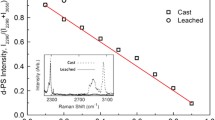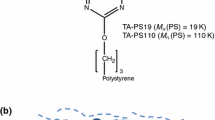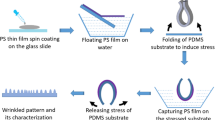Abstract
The wrinkling of a 50:50 blend of a high molecular mass (Mn = 990 kg/mol) and low molecular mass (Mn = 1.3 kg/mol) polystyrene (PS) film is studied as a function of annealing temperature and film thickness. Both thermal and mechanical wrinkling are utilized to elucidate the apparent modulus of these PS blend films. The PS blend shows a modulus comparable to the high molecular weight PS, ≈ 3.2 GPa for mechanical wrinkling at ambient and thermal wrinkling for T ≤ 50 °C. A sharp decrease in the apparent modulus of the film occurs when thermal wrinkling occurs at 60 °C or higher. The calculated modulus in this case is 0.5 GPa, which is significantly below the modulus determined the neat PS for either Mn when thermally wrinkled at T > 60 °C. This behavior is attributed to a combination of surface segregation of the low molecular weight PS as well as the large difference in bulk glass transition temperature (Tg) of each component. During thermal wrinkling, the high Mn PS vitrifies first, while the surface containing primarily low Mn PS is rubbery; this leads to only the underlayer of PS wrinkling initially and selection of a shorter wavelength due to the effective thickness. The increased thermally induced stresses during cooling when the low Mn PS is vitrified do not change the selected wavelength and instead only leads to an increase in the wrinkle amplitude. These results illustrate a potential method to modulate the wrinkle wavelength without changing the overlayer, which could be useful for patterning applications.
Similar content being viewed by others
References
P. H. P. Macaubas, N. R. Demarquette, Polymer 42, 2543–2554 (2001).
Z. M. Xie, J. Sheng, Z. M. Wan, J. Macromol. Sci., Phys. 40, 251–261 (2001).
H. Wang, R.J. Composto, J. Chem. Phys. 113, 10386–10397 (2000)
G. Yu, J. Gao, J.C. Hummelen, F. Wudl, A.J. Heeger, Science 270, 1789–1791 (1995).
C. M. Stafford, C. Harrison, K. L. Beers, A. Karim, E. J. Amis, M. R. Vanlandingham, H. C. Kim, W. Volksen, R. D. Miller, E. E. Simonyi, Nat. Mater. 3, 545–550 (2004).
J. M. Torres, C.M. Stafford, B.D. Vogt, Polymer 51, 4211–4217 (2010).
Y.F. Ding, A. Kisliuk, A.P Sokolov, Macromolecules 37, 161–166 (2004).
C. M. Stafford, S. Guo, C. Harrison, M. Y. M. Chiang, Rev. of Sci. Instrum. 76, 062207 (2005).
C. Jalbert, J.T. Koberstein, I. Yilgo, P. Gallagher, V. Krukonis, Macromolecules 26, 3039–3074 (1993).
M. Dion, A.B. Larson, B.D. Vogt, J. Polym. Sci B 48, 2366–2370 (2010).
R. Huang, C. M. Stafford, B. D. Vogt, J. Aerosp. Eng. 20, 38–44 (2007).
C. M. Stafford, B. D. Vogt, C. Harrison, D. Julthongpiput, R. Huang, Macromolecules 39, 5095–5099 (2006).
V. S. Minnikanti, Z. Qian, L. A. Archer, J. Chem. Phys. 126, 144905–144907 (2007).
Z. Qian, V. S. Minnikanti, B. B. Sauer, G. T. Dee, W. G. Kampert, L. A. Archer, J. Polym. Sci., Part B: Polym. Phys. 47, 1666–1685 (2009).
Author information
Authors and Affiliations
Rights and permissions
About this article
Cite this article
Torres, J.M., Vogt, B.D. Anomalous Behavior of Polystyrene Blends Using Thermally Induced Surface Wrinkling. MRS Online Proceedings Library 1301, 3–8 (2011). https://doi.org/10.1557/opl.2011.537
Published:
Issue Date:
DOI: https://doi.org/10.1557/opl.2011.537




